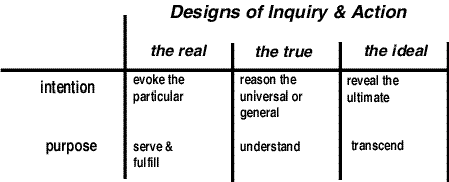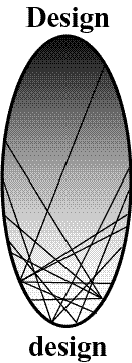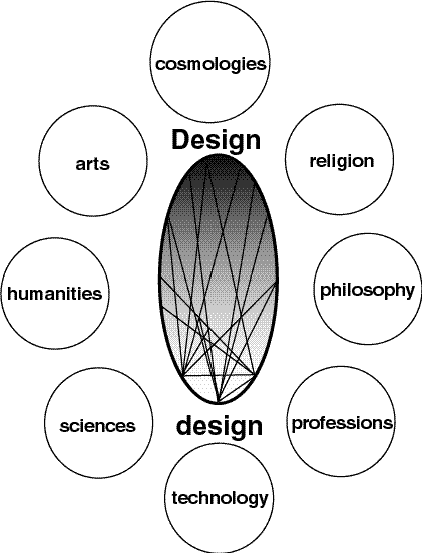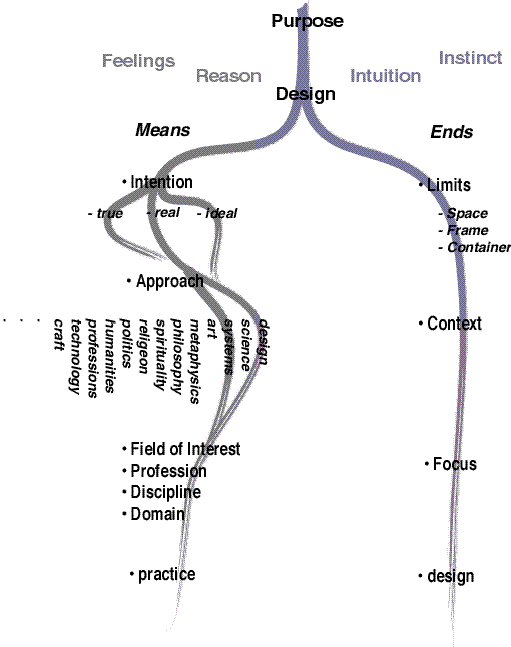
Harold Nelson
DESIGN CAPACITY - A BASIS OF HUMAN ACTIVITY
By Harold G. Nelson, Ph.D., M. Arch. DRAFT DRAFT -
Design is the ability to imagine, that-which-does-not-yet-exist, to make it appear in concrete or concretized form as a new, purposeful addition to the real world. Design is the first tradition among the many traditions of inquiry and action developed over time. We design our homes, our businesses and our lives as well as our material culture. Design touches nearly every aspect of our experienced world. We design to be human and we can design because we are human. Every human can and does benefit from design activity. It is an important capacity not only for those who are designed to be designers but for those who are served and benefited by design relationships with designers. Design is a valuable activity for anyone and everyone including managers, administrators, software designers, educators, community activists, environmentalists and professionals. (this is in addition to those considered to be designers by tradition).
There is a great deal of literature describing design as primarily a terminal activity of a more extended rational process that begins with a description and explanation (usually a problem statement) of an existing situation followed by a determination of alternatives or optimal solutions to this undesirable state of affairs. Design then comes into play as a process of creating objective and concretized artifacts that act as instrumental technologies enabling an intended change to take place. This is an extremely limited and limiting view of design however. Design is not just one element of a more comprehensive rational or intuitive process. Rather than being a tertiary activity it is primary, basic and pervasive in intentional human activity.
Design is a compound of both inquiry and action. The developed societies in today's world have typically divided people and their work into two different domains reflective of the hierarchy inherited from the Socratic Greeks. There are those who think and reflect and there are those who do or make. Formal education and technical training are defined by this duality. Design capacity however is the underlying unity a priori to the separation of human activity into these two domains. This separation, that is now taken for granted as a norm, hides the nature of design from us making it difficult if not impossible to access in every day activity. Design capacity is the basis for human agency. Because it has been distilled into the dyad of reflection and action for so long there is very little commonplace understanding of its basic nature.
Design capacity forms an essential part of the pallet supporting human activity. Human activity in this case is inclusive of both the activity of thinking and the activity of doing or making. Design capacity is basic and elemental to human activity in several ways (Nelson and Stolterman 2000). These include an understanding of design as a common everyday activity engaged in by everyone all the time focused on obtaining pragmatic and appropriate outcomes. It also includes design capacity as a form of intelligence integral to the architecture of the human brain, an ability to think and act in a designerly way (Cross 1982). It includes an understanding of design capacity as the generative basis of human agency as well that allows humans to participate in the ongoing genesis of the created world. Design capacity is also basic in that it is inclusive, integrative and emergent; an analogue state from which categories of designs of inquiry and action can be divided out. For instance, one such set of categories includes the true, the ideal and the real (see fig 1). Design capacity is the whole out of which these parts are formed.

Fig 1.
Design capacity allows humans to do what they most desire to do and that is to create and live in an unnatural world. Disease, danger, disaster are all naturally occurring events in the found world. Design is the means by which humans create a more desirable reality without these and a multitude of other undesirable natural attributes. A great deal of human effort is expended in this design process whose expected outcome is to change the nature of experienced life. Adaptation and adoption are the drivers of change in nature. All forms of life use these strategies in order to exist and propagate. Chance and necessity are the triggers for change for all life forms including humans. Human behavior however is augmented by design capacity.
Although sensing, feeling and emotion may be basic to all animals including humans, design ability is basic to being human. It is a way of making sense of the world because it is an approach that has the ability to create the artificial world through countless intentional and purposive acts. The continuously created artificial world is formed in such a way that it projects meaning onto the natural or normalized world that is otherwise incomprehensible in its chaos and complexity.
Instinct, intuition, and reason are all basic and essential capacities needed for us to engage successfully with the world in both its natural and unnatural forms. Each is a dramatically different way from the others of understanding the experienced world. Equally essential yet dramatically different by nature, design is not fundamentally about understanding the world, it is about making the world intentionally. Making the world as part of the ongoing genesis of human presence. The degree of design ability and activity makes the distinction between species that are not yet human and human beings. The ability to fully and authentically engage in design is what defines us as human in a basic but not exclusive way
The capacity for design thinking and action is not limited to any particular focus just as reason or intuition is not limited to specific situations. Reason, typically associated with the scientific method and scientific disciplines, is successfully applied in nonscientific situations. Design, like reason, is not specific to any particular domain of human inquiry or action. The focus of design thinking and action, as is true for reason or intuition, is defined by the particular intention brought to bear in any particular situation. Intention in this case is aim as in the aiming of an arrow. It is not the target nor is it the outcome.
Intention, when defined as art or science or philosophy or religion or technology, comes to us from the Western tradition. These of course are not universal or timeless forms of intention, they are just the most current. An example of earlier forms of intention would be those based on classic Greek categories that formed the basis for the curriculum of mediaeval universities; the trivium (logic, rhetoric and grammar) and the quadrivium (music, astronomy, arithmetic and geometry). Other cultures and traditions have other norms for making intention visible. New forms of intention such as systems thinking are emerging as viable candidates for inclusion in the cannon of forms of intention as well. Whatever the lineage of forms of intention they all serve to give focus or aim to design thinking.
In a self-referential way, design can be the aim of intention as well. Thus reason can be brought to focus on design as in design science. It is also true that design, as a basic human capacity for reflective thought and action, can be aimed at by means of design intention. This formulation illustrates the relationship between two complementary aspects of design. Design with a capital "D" and design with a lower case "d"; the universal and the particular (see Fig. 2). Design however is something more than just the relationship between these two manifestations and the manifestations themselves.

Fig. 2
This complimentary perspective of design capacity forms an image that is helpful in understanding the basis for the human ability to create worlds of experience that make sense to us. That is, as humans, we have and can design our cosmologies, our creation stories, social structures, organizations, institutions and relationships. We are able to design the many forms of intention that enable diverse expressions of human potential that in addition to cosmologies includes such forms of intention as religion, art, humanities, science, philosophy, professions and technology (see fig 3.).

Fig. 3
Design capacity as a basis for human activity that is both domain-independent and domain specific is difficult to comprehend when there is the expectation that apparent contradictions must be resolved. One way to resolve the tension between the two is to imagine they are merely projections of the same phenomena onto two very different frames of reference. Or they can be seen as terminus points of a conceptual hierarchy that is indifferent to direction. Thus design capacity, as the generative basis for human activity, can be resolved into design means and ends (see fig. 4). Means can be resolved into intention, approach, perspective and domain or field of interest. Ends can be resolved through successive steps leading from the universal, the particular to the ultimate particular. We can as easily take the ultimate particular as the starting point and reverse engineer our way conceptually back to design capacity as a universal capacity.

Fig. 4
Intention has been discussed previously but approach is an equally important concept in design in that it is grounded in action. For example there is a great deal of intellectual interest in such things as frames of reference, perspectives, view points, paradigms and worldviews (i.e. Weltanschauung). Individuals who are focused on changing complex social systems, for instance, engage in interventions that are meant to change these ways of seeing the world into better, more appropriate ways of seeing the world. However, describing and explaining the world, no matter how accurately or well it is done, does not prescribe action or change. In the same way prediction and control do not justify action. Action is prescribed and justified in other ways. What is needed in place of dependence on a worldview strategy is the inclusion of a world approach. Approach is a tradition of engagement and action that design capacity facilitates.
Professions and fields of interest are the means by which the particular and ultimate particular are evoked. They do not constitute fixed truths but are matters of convention. Architecture is a traditional means of focusing design activity in the built environment but applied science and schools of art have created physical environments for human dwelling as well. Creating or designing the ultimate particular is a basic activity in that it is grounded in a particular time, with particular people, for particular purposes using particular materials. It is not something that can be nor should be generalized or universalized. It is basic to the expression of a unique aspect of the created world defining its authentic character.
In addition to the reasons given above for design being a basis for human activity there is another reason that is equally essential but that has an important distinction from those already discussed. This is design capacity as the basis for service to human desires and needs (Nelson and Stolterman 2000). Design is based on the foundation of service relationships among individual people or classes of people like children, future generations or citizens. Design capacity is animated by purpose. Those being served by any particular design activity are the ones who bring purpose to that activity. Purpose does not reside in the universal or particular nature of design and it is not the same as intention. The means and ends of design activity are brought to life through the desires and needs of those who are being served by design behavior. Design capacity is fundamental to the realization of human purpose in the world.
__________
Cross, N. (1982). "Designerly Ways of Knowing." Design Studies 3(4).
Nelson, H. G. and E. Stolterman (2000). "The Case for Design: Creating a Culture of Intention." Educational Technology XL(No. 6): 29-35.
Nelson, H. G. and E. Stolterman (2000). Design as Being in Service. Foundations for the Future; Doctoral Education in Design. D. Durling and K. Friedman. Staffordshire, GB, Staffordshire University Press: 23-33.
Biographical Note
Dr. Harold Nelson graduated with distinction from the University of California at Berkeley. His Ph.D. in Social Systems Design was a program he designed through the Ad Hoc Ph.D. program, administered by the Dean of Graduate Studies. His dissertation focused on a systems approach to the impact on rural communities of large-scale resource development projects with an emphasis on value assessment. He received his Master of Architecture degree from the University of California at Berkeley as well. Prior to that upon receiving his Bachelor of Architecture from Montana State University, Dr. Nelson studied in Finland on a Scholastic Scholarship, becoming a Fulbright Alternate.
Currently Dr. Nelson is serving as past-president of the International Society for Systems Science and is president and co-founder of the Advanced Design Institute. He is presently working as an organizational systems design and education consultant for non-profit and for-profit organizations. His focus is in two areas. The first is on leadership and entrepreneurial capacity development based on systems thinking and advanced design theory. The second is on the development of design competencies in organizations.
For over twelve years Dr. Nelson was the Director of the Graduate Programs in Whole Systems Design (WSD) at Antioch University Seattle. Under his leadership the programs became nationally recognized in the field of systems design. One program was ranked among the top graduate programs in Organizational Development in the United States, a field that represented just one dimension in the overall design of the WSD curriculum. He was the primary designer of the degree programs as well as administrative manager and an academic resource for students. The student population consisted of adult students, primarily in mid-career or engaged in fundamental career changes.
He has worked with diverse organizations including non-profits and corporations, state and federal agencies, foreign governments and the United Nations. Dr. Nelson has made presentations, and facilitated workshops on a variety of topics including; leadership development, complex systems design, creativity and systems thinking. He has worked as a researcher, consultant and university educator in design and systems science. He has consulted or taught in countries as diverse as; Chile, Turkey, Finland, Indonesia, and Australia. Currently, Dr. Nelson is a member of the Systems Renewal Institute's Learning Resource Council and is a member of the Design Research Society.
Prior to his work in the fields of organizational systems design, leadership development and educational systems design Dr. Nelson, a licensed architect in the State of California, worked as a practicing architect in private practice and as an assistant regional architect for region V of the U.S. Forest Service.